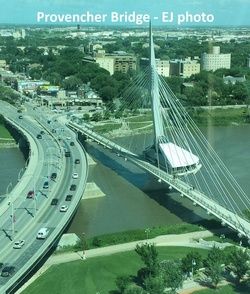
I do love Winnipeg. I am winding up a week in Winnipeg. Winnipeg has world-class shopping, entertainments, cultural experiences, museums and archives, neighbourhoods, people . . .
However.
Just on general principle, I hate cities. I hate cities because of the traffic, the pollution, the crowdedness, and I must also mention, again, the traffic.
I just hate driving in cities.
For the first few days in Winnipeg, I took every horn honk as a personal rebuke. Didn’t matter if the horn was honking behind me, or three cars over, or at the end of a broad parking lot. I took it as a personal rebuke to my driving skills . . . of which I still have a few. But they do seem to deteriorate in cities.
Even walking in cities can be discombobulating. In the downtown, when I’m waiting to cross a busy street, suddenly a chipmunk starts chirping over my shoulder. I glance wildly about. No wildlife whatsoever. When I bring my attention back to the traffic light, which is now signalling me to cross, all my pedestrian companions are halfway across. I stumble awkwardly behind them.
Parking is usually an ordeal. Cities are not designed for car parking. Or is it the other way around? To begin, signs are confusing, apparently on purpose. Try reading a postage-stamp-sized one at 50 klicks an hour (which is, apparently, the minimum speed, if you wish to appease the horn-honkers). You can, apparently, park on certain designated streets at certain designated times on certain designated days if you can, apparently, find an open space. That’s after, apparently, you have managed to read the sign in part or in whole and not, in your haste, in error.
Yes, even when you find a genuine parking lot that will, apparently, host dozens and sometimes hundreds of cars, the ordeal may not be over. Yesterday, at The Forks, I spent 30 minutes . . .
Read E.J. Lavoie's complete post at http://bit.ly/262Osgs .
P.S. The author did not have an opportunity to revisit the Gate on this trip. But, through heavy traffic, he caught a glimpse of it, and can verify that this monument retains its splendid isolation.
However.
Just on general principle, I hate cities. I hate cities because of the traffic, the pollution, the crowdedness, and I must also mention, again, the traffic.
I just hate driving in cities.
For the first few days in Winnipeg, I took every horn honk as a personal rebuke. Didn’t matter if the horn was honking behind me, or three cars over, or at the end of a broad parking lot. I took it as a personal rebuke to my driving skills . . . of which I still have a few. But they do seem to deteriorate in cities.
Even walking in cities can be discombobulating. In the downtown, when I’m waiting to cross a busy street, suddenly a chipmunk starts chirping over my shoulder. I glance wildly about. No wildlife whatsoever. When I bring my attention back to the traffic light, which is now signalling me to cross, all my pedestrian companions are halfway across. I stumble awkwardly behind them.
Parking is usually an ordeal. Cities are not designed for car parking. Or is it the other way around? To begin, signs are confusing, apparently on purpose. Try reading a postage-stamp-sized one at 50 klicks an hour (which is, apparently, the minimum speed, if you wish to appease the horn-honkers). You can, apparently, park on certain designated streets at certain designated times on certain designated days if you can, apparently, find an open space. That’s after, apparently, you have managed to read the sign in part or in whole and not, in your haste, in error.
Yes, even when you find a genuine parking lot that will, apparently, host dozens and sometimes hundreds of cars, the ordeal may not be over. Yesterday, at The Forks, I spent 30 minutes . . .
Read E.J. Lavoie's complete post at http://bit.ly/262Osgs .
P.S. The author did not have an opportunity to revisit the Gate on this trip. But, through heavy traffic, he caught a glimpse of it, and can verify that this monument retains its splendid isolation.
 RSS Feed
RSS Feed
